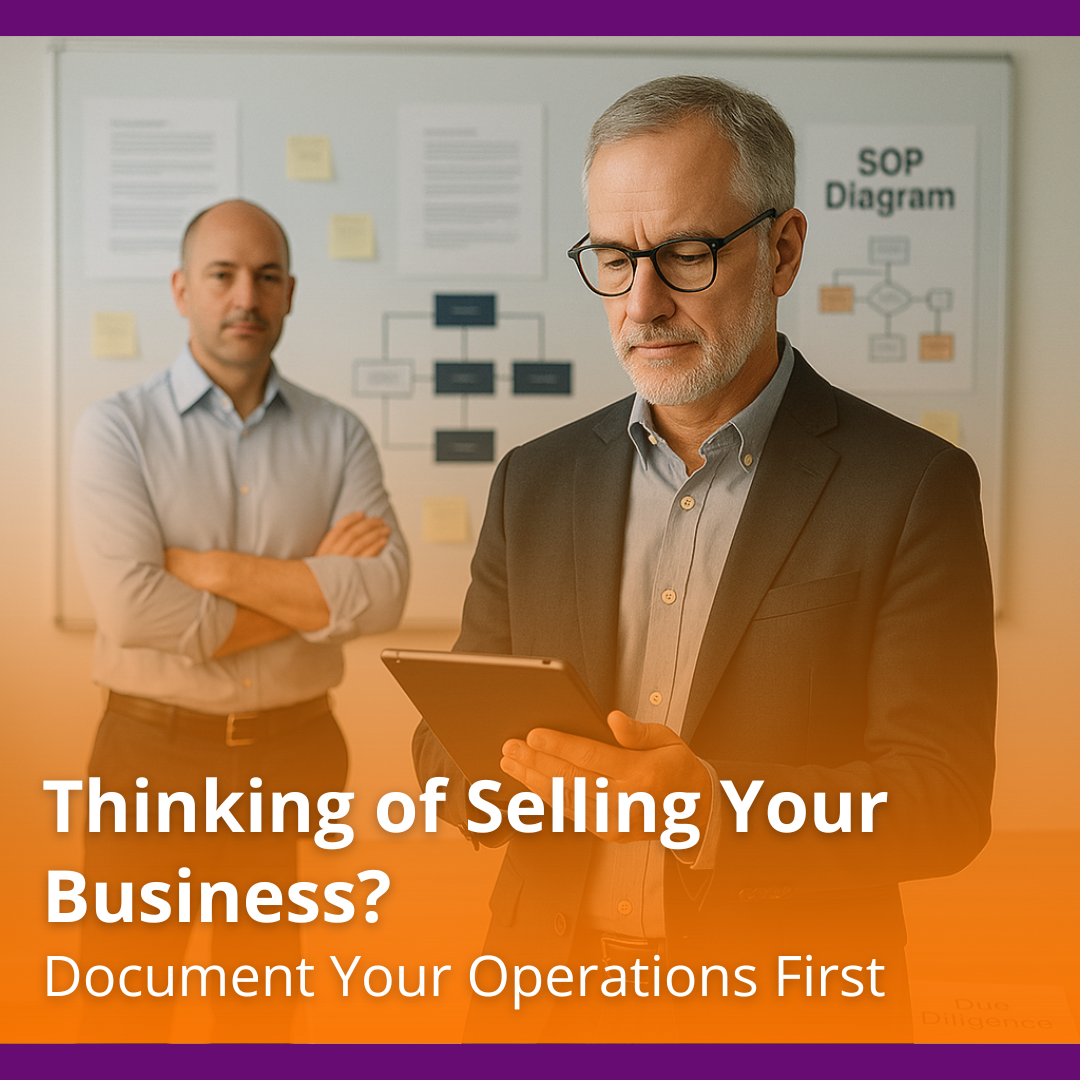Thinking of Selling Your Business? Document Your Operations First
Running a business means knowing every moving part. But to a buyer, that knowledge means nothing if it isn’t documented. And that’s a...
Comprehensive, data-driven valuations and comparative equity analyses to accurately price your practice, establish market benchmarks, and support informed decision-making.
Comprehensive M&A guidance encompassing deal structuring, negotiation strategies, market listings, and transaction closings.
Comprehensive systems, targeted coaching, and in-depth assessments designed to optimize operational efficiency and enhance advisory team effectiveness.
Strengthen continuity through the implementation of formal continuity agreements, the establishment of legal entities, execution of enforceable legal contracts, and securing appropriate capital resources.
11 min read
 Todd Doherty
June 30, 2025
Todd Doherty
June 30, 2025

What’s the fastest way for a financial advisor to double their client base, without spending years prospecting?
According to Global Market Insights, the advisor M&A market is on a strong upward trajectory, projected to reach $146.8 billion by 2032. This growth reflects a broader shift: more firms are turning to acquisitions as a deliberate strategy to scale efficiently and strengthen their revenue base.
Jonathan Kuttin, a top advisor at Ameriprise, has completed over twenty acquisitions using a structured, repeatable process. His approach centers on clear criteria, strong operational systems, and professional deal support. For those considering a first purchase—or refining their buying approach—Kuttin’s strategy offers practical insight into how to identify the right fit, structure the deal, and maintain client trust throughout the transition.
Acquiring a practice is a powerful way for a financial advisor to achieve significant growth. It provides immediate access to an established client base, a stable source of recurring revenue, and a larger pool of assets under management. This strategic move allows an advisor to focus on delivering high-quality service and financial planning rather than spending years on the slow, linear process of client prospecting. It is a deliberate decision to scale operations and expand market presence.
Organic growth, which relies on attracting new clients one by one, is a gradual process. Buying a book of business, in contrast, provides an immediate and substantial increase in size. This injection of clients and assets allows a firm to achieve economies of scale much more quickly. With a larger operational base, an advisory business can often negotiate better terms with vendors, access more sophisticated technology platforms, and create more specialized roles for team members. This allows the lead advisor to delegate administrative tasks and focus on high-value activities such as client strategy and business development. Jonathan Kuttin’s journey to becoming one of Ameriprise’s top five practices was significantly shortened through this method, demonstrating its power as a growth accelerator.
Another compelling reason to purchase a financial advisor practice is the opportunity for diversification. An acquisition can introduce new revenue streams and client demographics to the buyer's firm. For instance, an advisor who primarily serves retirees might acquire a practice with a younger client base of small business owners. This not only balances the firm's demographic risk but also opens up new service opportunities, such as complex financial planning for business succession. Similarly, a fee-only practice might acquire a book with commission-based products, or vice versa, creating a more blended and resilient revenue model. This diversification can protect a firm from market shifts that might disproportionately affect a single type of client or revenue source.
Many acquisitions are born from another advisor's need for a succession plan. The purchase is not just a growth opportunity for the buyer, but also the culmination of a selling advisor's lifetime of work. By acquiring the practice, the buyer provides a responsible and orderly transition for a colleague looking to retire. This creates a win-win scenario. The seller can exit the industry with confidence, knowing their clients will be cared for by a capable successor. The buyer gains a loyal client base that has been personally introduced and endorsed by their trusted, long-time advisor. This warm handoff is invaluable for ensuring high client retention rates and a smooth continuation of service.
Before an advisor even begins looking for a practice to buy, a period of internal assessment is critical. Jumping into the market without a clear plan can lead to a poor fit or an unmanageable transition. A buyer must first evaluate their own firm's readiness from a strategic, financial, and operational standpoint.
The first step is to create a detailed profile of your ideal acquisition target. This goes far beyond the size of the book of business. A buyer should clearly define the characteristics that would make a practice a good fit. This includes the seller's investment philosophy, ensuring it does not fundamentally clash with your own. Consider the client service model; if you run a high-touch, meeting-intensive practice, acquiring a book of clients accustomed to a digital-only service model could create friction. Firm culture is another important element, especially if you plan to retain any of the seller's staff. Finally, think about geography, client demographics, and the types of financial services offered. A clear profile acts as a filter, allowing you to quickly identify promising opportunities and pass on those that are not a strategic match.
Acquiring a financial practice requires significant capital. A buyer must have a clear understanding of their financing options well before making an offer. Common funding sources include traditional business loans from banks that specialize in advisor acquisitions, seller financing, where the selling advisor agrees to receive payments over time, or the use of personal capital. It is important to remember that the purchase price is not the only cost. A buyer must also budget for transaction costs, such as legal and consulting fees, and have sufficient working capital to manage the transition period. There may be a temporary dip in revenue as clients are integrated, so having a financial cushion is a necessary part of responsible planning.
Jonathan Kuttin’s experience highlights a crucial point: you must have robust systems and processes in place before you acquire another practice. An influx of new clients can strain a firm's operational capacity. If your current systems for client relationship management (CRM), compliance, portfolio management, and client reporting are already at their limit, they will likely fail when you double your client base overnight. A buyer must ensure their technology stack is scalable and their workflows are efficient. The goal is to absorb the new practice with minimal disruption to the service provided to both new and existing clients. Being operationally ready is a prerequisite for a successful integration.
The search for the right practice is a foundational step. A potential buyer must assess more than just the number of clients or the total assets. They need to understand the value of the book, the specific financial needs of the clients, and how the advisory business has been managed.
An advisor can find a book of business for sale through their own networking or by using professional listing services. Jonathan Kuttin found that a specialized platform like Advisor Legacy was best at pairing him with the right sellers. These platforms act as a marketplace, providing access to a wide range of opportunities that might not be available publicly. A significant benefit of using such a service is the ability to filter searches based on specific criteria, such as locating practices for sale within an advisor’s existing broker-dealer family. This alignment makes the final client transition and operational integration much easier to facilitate.
Not every book of business is a good fit. Finding the right practice is crucial for a smooth transition and ensures the acquisition improves the overall business. Alignment is key. A potential buyer should look for a practice with a similar investment philosophy, a compatible client service model, and a company culture that matches their own. For example, a buyer focused on holistic financial planning should be cautious about acquiring a book built solely on asset management. The existing clients have certain expectations, and a drastic change in service could lead to low retention. Due diligence performed by both the buyer and the selling advisor is essential to confirm this strategic and cultural fit.
Beyond online platforms, some of the best acquisition opportunities are found through professional networks. This includes engaging with colleagues in study groups, attending industry conferences, and making your intentions known within your broker-dealer or custodian network. Many quality practices are sold privately without ever being listed publicly. Working with an M&A consultant or business broker who specializes in the financial advisory space can also provide access to these off-market deals. These professionals have deep industry connections and can proactively identify potential sellers who match your ideal acquisition profile.
Once a potential target is identified, the initial approach must be handled with professionalism and discretion. The process of selling a business is a sensitive one, and sellers are often concerned about confidentiality. They do not want their clients or staff to know the practice is for sale prematurely. A serious buyer should be prepared to sign a non-disclosure agreement (NDA) early in the process. This legal document protects the seller's confidential information and signals that the buyer is a professional who respects the gravity of the transaction. A respectful and confidential approach sets a positive tone for the negotiations that may follow.
After an initial connection is made and confidentiality is established, the process moves into a more formal stage of analysis. This is where a buyer must objectively determine the practice's true value and verify all the information provided by the seller. This phase is critical for structuring a fair offer and avoiding future surprises.
A thorough business valuation is the starting point for any fair transaction. It provides an unbiased market value and establishes a transparent baseline for negotiating the purchase price. While valuation can be complex, it is typically based on a multiple of the practice's recurring revenue or seller's discretionary earnings. Valuation experts or appraisers will produce a detailed valuation report or appraisal. This report analyzes key metrics such as revenue sources (fee-based vs. commission), client retention rates, client age demographics, and the concentration of assets among top clients. For example, a practice with stable, fee-based revenue and a low concentration of assets will typically command a higher multiple than one with volatile, commission-based revenue and a few very large clients.
Effective due diligence goes far beyond checking the numbers. It is about understanding the seller’s client relationships and the operational structure of the advisor’s practice. This deep investigation should include a thorough review of the firm’s compliance history, including its Form ADV and any past regulatory issues. The buyer should assess the practice's technology stack to understand its capabilities and potential integration challenges. It is also important to review staff contracts, client agreements, and any office lease agreements. An objective third party, such as an M&A consultant, can be very helpful in this stage to manage expectations and ensure all important details are reviewed with an experienced eye.
Once the financial advisor's book of business is purchased, a detailed transition plan is essential. The work of the acquisition is not over in many ways; it has just begun. The buyer must be prepared to onboard the existing client base effectively to maintain client trust and satisfaction. The selling advisor often plays a collaborative role in this process.
A structured process is needed for onboarding new clients. Jonathan Kuttin emphasizes having operational processes ready to handle the influx of work. A clear communication plan, including professional letters to introduce the change, helps the existing client base feel secure. This initial communication should come jointly from both the seller and the buyer to show a united front. The transition plan should include a timeline for personal outreach, with the buyer making an effort to meet with the most significant clients as soon as possible. The goal is to make every client feel valued and to demonstrate that their financial well-being remains the top priority. This proactive approach is fundamental to achieving a high client retention rate.
Not all clients in an acquired book of business are the same, and they should not be treated with a one-size-fits-all communication strategy. A best practice is to segment the client base immediately after the deal closes. This can be done based on criteria such as assets under management, age, complexity of their financial needs, or their relationship with the selling advisor. Once segmented, the buyer can create a targeted communication plan for each group. The top-tier clients might receive a personal phone call and an invitation for an in-person meeting within the first few weeks. Other segments might be invited to a small group lunch or a webinar. This tailored approach shows that the new advisor understands the client base and is making a deliberate effort to connect with them in a meaningful way.
A smooth transition also depends on successfully integrating the operational side of the business. If the buyer is retaining any of the seller's staff, a plan must be in place to integrate them into the new firm's culture and procedures. This includes training on new software, clarifying job roles, and establishing clear lines of communication. Technology integration is another critical task. This can involve migrating client data from one CRM to another or moving assets to a new custodian. These technical processes must be managed carefully to avoid errors and service disruptions. A well-documented plan for integrating people and systems is just as important as the client communication plan.
A comprehensive succession plan involves more than just the purchase price; it defines the terms and responsibilities for both parties during the transition. The selling advisor’s participation in the initial handover is often the single most important factor in client retention. Their introduction and endorsement of the new owner build immediate trust in a way that the buyer cannot achieve alone. The purchase agreement should clearly outline the seller's role. Will they stay on for a set period, such as three to six months? What will their responsibilities be? An experienced M&A team can help structure this part of the deal to ensure the seller is properly motivated to facilitate a successful transition for the clients they have served for years.
Jonathan Kuttin built one of the top Ameriprise practices by strategically buying another advisor’s book of business, again and again. His success provides a clear model for growth through acquisition, showing how a repeatable process can lead to extraordinary results. His story is a practical lesson in how to turn a series of individual transactions into a cohesive and powerful growth engine.
For Jonathan Kuttin, acquisitions are a core part of his business philosophy. He sees each purchase as an opportunity to provide a continuity solution for a retiring advisor while offering a more robust service platform for their clients. His goal is not simply to get bigger, but to get better. He looks for practices where he can add value, either by introducing more comprehensive financial planning, upgrading the technology, or providing access to a deeper team of specialists. This philosophy of improvement guides his selection process and ensures that each acquisition strengthens his overall firm. He believes that growth should be purposeful and that scale should be used to enhance the client experience.
Mr. Kuttin’s approach is systematic. He has now completed over twenty acquisitions, and he credits this success to a refined process that he follows for each deal. He works closely with Advisor Legacy to find a book of business for sale that aligns with his specific growth goals, often focusing on practices within the Ameriprise network to streamline the transition. The process begins with a deep analysis of the practice to ensure a good fit. He emphasizes that due diligence must go both ways; the seller should feel as comfortable with him as he does with their practice. He credits a structured deal process with helping him get from the initial search to a signed purchase agreement efficiently. He values having an objective third party like Advisor Legacy and its M&A expert, Todd Doherty, involved. He found their experience beneficial in managing negotiations and getting the deal to the finish line in a way that was fair for everybody.
He credits a structured process with helping him get from the initial search to a signed purchase agreement. The deal structure, valuation expertise, and turnkey support were all important. He found Advisor Legacy's process to be straightforward, organized, and efficient. He particularly noted the value of having an experienced, impartial third party to help deliver messages that can be difficult for a buyer to deliver directly to a seller. This helps in setting reasonable expectations around the terms of the deal. This professional mediation ensures that the negotiation phase remains productive and focused on creating a mutually beneficial outcome, preventing the emotional aspects of a sale from derailing the transaction.
Based on his extensive experience, Jonathan’s advice for other advisors is direct and practical. He stresses that a buyer must be ready to evaluate the purchase price and client base with careful attention to detail. It is essential to build strong internal systems before you acquire another advisor’s book of business to handle the increased scale. He also advises leaning on experts for valuation, succession planning, and legal support to ensure all aspects of the deal are handled correctly. Finally, a buyer must plan ahead with a clear and proactive communication strategy to retain clients during the transition. Success is found in preparation.
Buying a book of business requires knowledge of business development, succession planning, and financial planning. A financial advisor must be clear about their business goals, have access to capital or business loans, and be ready to manage the onboarding process. Partnering with a specialized firm can provide the necessary structure and expertise.
Advisor Legacy offers services to manage the entire process, from the initial valuation to the final transition. Their turnkey deal-making services are offered for a flat fee and provide a comprehensive structure for one of the most important transactions an advisor can make. This process includes a thorough business valuation, help with negotiations and deal structuring, and coordination with attorney partners to finalize contracts. If financing is involved, the team can work with the buyer's bank to complete the deal. This end-to-end support allows the buyer to focus on the strategic aspects of the acquisition while the procedural details are managed by an experienced team.
If you're looking to buy a financial advisor book of business, start by clarifying your goals. A clear vision for your firm's future is the first step. Next, get educated on the market by using tools like financial advisor practice valuation calculators or by hiring a valuation expert. This will give you a realistic understanding of what practices are worth. Review your internal systems and operational capacity to ensure you are prepared for growth. Finally, take the step to engage with the market professionally. Understand what kind of financial practice you want to run.
Buying a book of business can bring tremendous growth, but only if done with preparation, expert support, and dedicated care for the clients you acquire. To take the next step in your growth journey, explore practices for sale or get a professional business valuation to guide your decision.
Todd Doherty serves as Vice President for Advisor Legacy, where he leads advisors through the full M&A lifecycle—readiness, valuation analysis, buyer/seller matching, due diligence, and post-close integration. With more than 15 years in senior roles at financial advisory firms and hands-on ownership experience, Todd brings an operator’s lens to every engagement. His writing focuses on practical ways to boost enterprise value, structure win-win deals, and avoid execution risk. Todd collaborates closely with the firm’s valuation, lending, and legal partners to help advisors make confident, data-driven decisions.
Receive timely articles, tip sheets, events, and more right in your inbox.

Running a business means knowing every moving part. But to a buyer, that knowledge means nothing if it isn’t documented. And that’s a...

Growing by acquisition is one of the fastest ways to scale — but it’s also one of the easiest ways to stumble. Behind every successful deal is a...

The M&A landscape in financial services isn’t slowing down. It’s evolving. Fast. As of mid-2025, deal values in the sector have surged by...